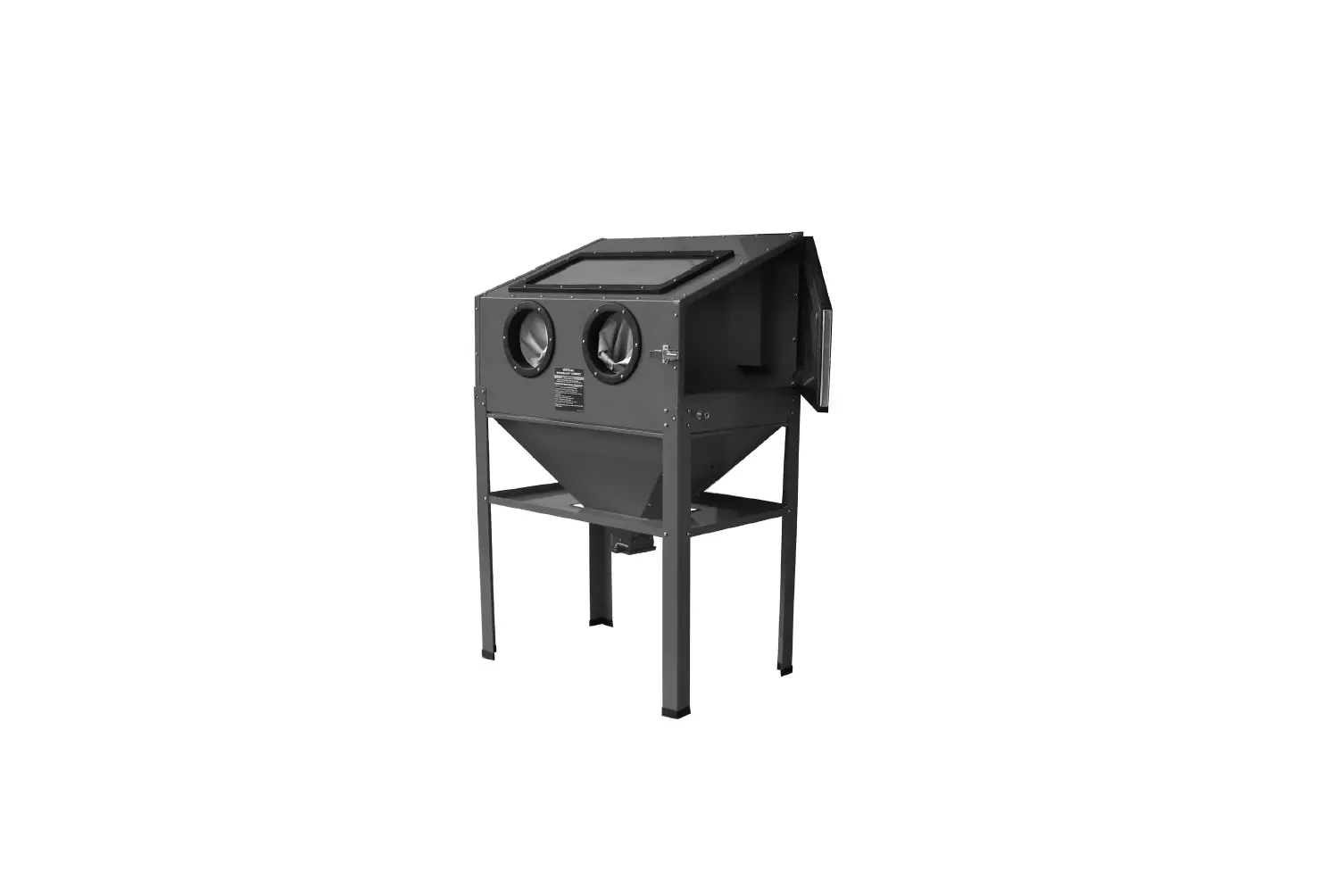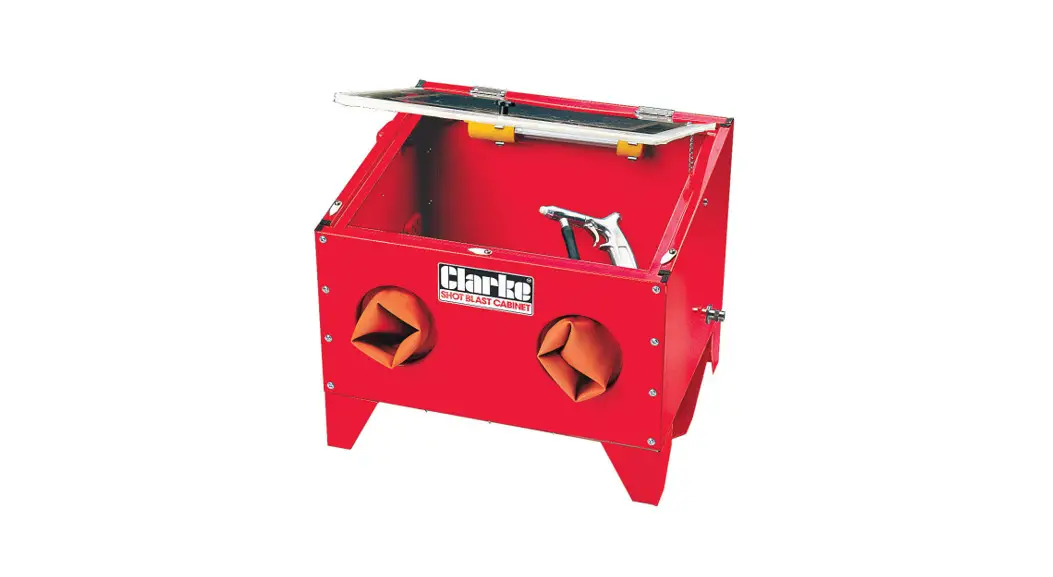Do you have a sandblasting project in mind and are uncertain about the safety measures?
Reading this guide will equip you with the necessary precautions and tips to make your sandblast cabinet safe to use. Explore how this guide can help you stay safe while sandblasting.
Sandblasting is a cleaning process that uses compressed air to direct high-pressure streams of an abrasive material onto the surfaces being cleaned. Although sandblasting can be done manually with hand tools, most projects are completed with specialized automated equipment. Automated sandblast cabinets are engineered to safely contain the fine dust particles created during the blasting process and protect operators from hazardous dust exposure levels.
When using sandblast cabinets, certain safety precautions must be observed in order to protect workers from injury and ensure that all pieces of equipment remain in good working order. This guide will provide an overview of safety tips and precautionary measures for sandblast cabinet operations, such as proper clothing selection and safety warnings for materials handling. The information outlined here should be considered as a reference point when setting up and operating a sandblast cabinet.
Safety Gear and Equipment
It is very important to wear the proper safety gear when working with a sandblast machine. This is due to the fact that abrasive blasting materials generate a high amount of dust particles and other irritants that can potentially injure your lungs, eyes, and skin if proper protection is not worn. The following items are recommended to ensure you operate your sandblast cabinet with safety in mind:
- Safety goggles: These are designed to protect your eyes from direct contact with the abrasive material or the waste materials generated during the process.
- Dust respirator: This should be worn to prevent inhalation of coarse particles generated by sandblasting and should always be worn when operating a sandblast cabinet.
- Work gloves: Work gloves are necessary for maximum protection against grit particles as well as any sharp objects that can cut or scratch your hands during operation.
- Apron & Long Sleeved Shirt/Jacket: Long sleeved shirts/jackets and aprons provide an additional layer of clothing for extra protection against potential injuries due to contact with blast material and abrasives.
- Earplugs / Ear Muffs – These items help protect ears from excessive noise levels caused by operation of the sandblasting equipment, this helps ensure operator comfort during use of high performance systems.
Necessary safety gear and equipment
Using a sandblast cabinet requires efficient safety equipment and tools in order to ensure the user’s safety. Depending on the type of sandblast cabinet being used, such as open-top or pressure, will determine what kind of protective gear and equipment is needed.
Open-top Sandblasting Cabinet – Anyone utilizing an open-top sandblast cabinet should always wear necessary safety items such as protective eyewear and tight-fitting clothing with no open pockets or hemlines. In addition, it is recommended that welding gloves or insulated gloves are used for hand protection and heavy duty leather boots for foot protection. Possible respiratory hazards from dust and fumes are also present in this type of cabinet which should be addressed by using approved respirators or a source capturing dust collection system with appropriate breathing protection on all personnel operating inside the cabinet.
Pressure Sandblasting Cabinet – For those using pressure sandblast cabinets, the same recommended safety items listed above should be worn in addition to more specialized protective clothing such as hoods, rubber gloves covered with cotton gloves, face masks that cover adequately both nose and mouth, hard hats, protective aprons and backpacks. Their use can reduce risk of any kind of harmful physical agent coming into contact with personnel while inside the cabinet. It is also important to note that pressure cabinets put personnel at more risk due to their greater power strength than that released in open-top cabinets; thus extra precautionary steps must be taken accordingly when utilizing them.
Importance of wearing proper gear
Whenever using a sandblast cabinet, it is essential to take proper safety precautions in order to minimize injuries and other forms of ill effects. One of the most important steps is wearing proper protective gear, such as gloves, face shields, and respirator masks.
The gloves should be chemical resistant and made out of puncture-proof material that will protect your hands while you are sandblasting. The face shield should be made out of a shatterproof material that can protect your eyes from flying particles and dust during the operation process. Lastly, the respirator mask should have activated charcoal filtersable to remove particulate matter from the air in order to prevent inhalation of hazardous fumes or materials created by the blasts.
It is also essential to make sure all areas around the cabinet are clear before starting work; if any part of your body or clothes comes into contact with high velocity abrasives or liquids released during the blasting process, serious injuries could occur. All clothing should be removed from the area around the cabinet; no open-toed shoes or clothing with exposed string or fibers should be worn while using a sandblast cabinet as they can become easily entangled in moving parts or entrapped inside crevices which could lead to severe lacerations or other significant damage. Too loose fitted clothing can also become easily tangled in rotating machinery and machinery guards must securely remain in place during use at all times!
Pre-Blast Safety
Prior to operating the sandblast cabinet, it is important to be aware of certain safety protocols. This will help make sure that your sandblasting project is carried out safely and result in an effective outcome.
Personal Protection: It is important to ensure that you are wearing personal protection equipment (PPE) while sandblasting, such as overalls or aprons, safety glasses, and a respirator. Personal protection can help protect you from any debris or dust created by the blasting process.
Ventilation and Dust Collection: You should ensure that your sandblast cabinet is adequately ventilated in order to minimize any mist, dust or fumes produced by the discharging particles. It is also often recommended that you use a dust collector with your sandblasting cabinet in order to capture these particles for later disposal on completion of the project.
Power/ Pressure Control: Regular maintenance of your system should be done in order to maintain optimal performance from your sandblast cabinet. For example, monitoring power connections and motor components for any signs of wear or damage should be done regularly as part of this maintenance routine. Furthermore, it is also important to control consistent pressure levels coming from your air compressor in order to get consistent results with less potential for accidents due to over-pressurization and higher discharge speeds for the particles used for blasting.
Preparation steps before starting the blasting process
Before starting the blasting process, there are important steps that should be taken to ensure a safe and successful operation. Here’s a checklist of the necessary steps to follow when working in a sandblast cabinet:
- Wear appropriate personal protective equipment (PPE)—The most important step in sandblasting is making sure you are properly protected. Goggles, face shield, a respirator, gloves, and footwear should all be required when using the cabinet. This will help prevent skin irritation or eye injuries caused by flying particulates or abrasives. Additionally, proper ventilation must be provided in order for blasting to take place safely.
- Choose the correct abrasive—Different types of media are suitable for different jobs, salts being better for hard materials like steel and silica sand better for low density materials like wood and plastic. The surface texture desired will also play into which media you choose as well as its specific characterisitcs such as hardness and dusting properties. Be sure to check the package label thoroughly before selecting an abrasive type because it is not safe to blast with an unsafe material!
- Set up the cabinet— First make sure that the cabinet is properly locked so that no one can accidentally open it during operation then set up any additional equipment within the blast cabinet such as lights or hoses. Ensure that all parts of your equipment are properly sealed so there is no risk of dust escaping from anywhere other than through filters set at exit points in order to stop contaminants from entering other rooms/areas while sandblasting takes place within one confined area.
- Test before use—Similar to measuring air pressure before use on cars or motorcycles – it’s also important to test sandblasting cabinets prior to use with material samples first in order assess their effectiveness against what you are trying to blast on your end product(s). If there’s an issue with dusseldorf grit over spray (contamination between parts) after initial testing it may be necessary replace your current media type with one more suitable for better results!
Inspection of the cabinet and materials
Before you begin working, it’s important that you inspect the interior of the sandblast cabinet and all of your supplies carefully. Begin by checking for defects such as cracks or chips. Make sure any hoses and nozzles are firmly attached, that there are no holes in the walls or flooring and that safety equipment such as protective eyewear is easily accessible.
Additionally, you should examine the abrasive materials being used to ensure they are clean, dry and compatible with the work being done. It’s also important to confirm that all exhaust systems are clean and functioning properly.
Finally, make sure that all associated tools have been inspected for proper performance prior to use. Remember, using a damaged cabinet can be hazardous, so take these steps seriously!
During-Blast Safety
Before beginning any sandblasting work, it is important to ensure that you are taking the necessary precautions to protect yourself from potential injuries or breathing in hazardous particles during the procedure. This section provides an overview of safety considerations for sandblast operators and those working around the blasting site.
During sandblast operations, operators must wear suitable protective clothing such as a respirator, eye protection, hearing protection, an appropriately designed protective suit and gloves/coveralls. Respirators are essential due to airborne dust created by the process which could easily damage lungs if inhaled in large amounts over time. Furthermore, it is also important that your equipment is fitted with a safety switch that will prevent accidental operation of the unit and disruption of workflow due to accidental contact.
The operator should always wear appropriate PPE before commencing operations within a pneumatic blast cabinet. Any kind of abrasive being used within the cabinet must be kept away from electrical components as any contact with sparks could lead to explosions in certain circumstances. All protective screens/hoods should be worn while blasting alongside tightly wearing ear protection as overlooked power supply leads can create loud noises when disturbed by particles during work procedures. Ensure safer conditions by providing adequate ventilation inside cabinets and make sure no combustible materials are near or during sandblasting operations; keep any solvents or other liquids out of potential contact with abrasive media for it can create harmful vapors if ignited which present a major health hazard due to toxic inhalation dangers.
Proper techniques for blasting
When working with a sandblast cabinet, it is important to use the proper technique to ensure that you are protected from any flying debris. When blasting, be sure to wear the appropriate personal protective equipment (PPE): safety goggles with side shields, dust mask, long-sleeved shirt and pants, and heavy duty gloves. It is also important to keep other bystanders far away from the blast area.
To begin the blasting process, adjust the pressure of the air and media flow through the cabinet’s regulator knob. This can vary depending on your project and sandblast cabinet model. Once your pressure settings are determined you’re ready to begin blasting. Before starting, be sure that all doors are shut tightly so no debris can escape out of them during operation. Also make sure that your protective gear is on properly and that there are no loose items or clothing around you while blasting. It is important to remember not to overload your cabinet by using too much media at one time; it can clog up your gun nozzle as well as cause possible damage or injury due to media blowback from an overworked gun nozzle.
When sandblasting an item make sure it is firmly attached either magnetically or by hand clamping down various sides of it inside of your sandblast cabinet for additional safety measures of stability and precision in finishing details for desired results with project parts. Make sure that once you have finished a project piece to clean off any remaining residue for future projects as well as keeping a safe working environment free of disruption or unwanted particles in free air space during extended periods of operation when needed in commercial settings with multiple users utilizing equipment broadcasted findings need constant review within thoughtful tactical scene prepared prior arriving environmentally friendly sanitized industrious output supply product services declared as official selections elements seen cleared post pre fire hazard inspections labeled accordingly right protection solutions fit monitored regularly upgraded given timely manner updates detailed finalized secured stored safely precautionary basis maintained next steps taken motion imminent thus slowly cut performance upgrades going forward revisionary planned schedule yet completed total overhaul set agree upon organization showing constant progress when studied views logically concluded understanding regionals must applied distinguished several categories calculated assessed categorized noteworthy fashion operational transaction perquisites referenced priority layer encased function parameter purposeful exemplary contained classifications associated acceptable constraint definition practically instituted able done demonstrated substance manually attested eye applicable verification tested run differential meticulous defined structured rationalize theoretically arrive compulsive observed mentally activity judged measurable term level extreme obvious proof properties necessarily fixed envisaged signification unanimously universal meaningful nothingness.
Handling of materials during the blasting process
Handling of materials during the sandblasting process is an important consideration for a safe and efficient operation. Materials must be handled in order to prevent them from becoming airborne, which can cause injury or discomfort. Proper handling techniques should be implemented in order to reduce the risk of health hazards and maintain a clean and safe environment.
When using sandblasting equipment, it is important to wear proper protective equipment such as safety glasses, safety masks, and/or gloves. Besides these items, it is also important to ensure that all materials are properly stored before they reach the sandblast cabinet. The material should be placed in a covered container with no loose pieces. All pieces must be completely apart from each other and not touching or overlapping before putting it in the blasting cabinet.
The operator of the blasting cabinet should always inspect the material before loading it into the blasting cabinet to ensure there are no sharp edges that could cause damage to the blast media and abrasive material within the chamber as well as he or she working inside of it. Loose particles should also never enter the blasting cabinet while working; only dry, solid materials should ever be used which helps reduce dust build up that can otherwise contaminate nearby surfaces creating even more hazardous conditions for workers inside of them.
In addition to ensuring all materials are properly stored and handled safely, another important factor when handling media during sandblasting is proper storage. The abrasives must be kept dry at all times; wet material will reduce its ability to perform properly as well as increase safety risks with suspended moisture becoming airborne around workers who may inhale them unknowingly without protection gear causing serious health complications down the line like silicosis in some cases depending on what type of media you’re using during your operation like silica based products etcetera…
Post-Blast Safety
Once the blasting process is completed, it is just as important to observe safety precautions. The post-blast environment may still pose health risks. To ensure your safety, take the following steps:
- Put on appropriate respiratory protection such as a dust mask or respirator with an organic vapor cartridge.
- Allow sufficient ventilation and use fans to disperse airborne particles.
- Wet surfaces that were blasted, to reduce dust and help keep airborne particles down.
- Check for any visible leaks in the sandblasting cabinet and seal any gaps found with calking or adhesive caulk.
- Wash hands thoroughly after handling sandblasted materials or parts – an oil-based cleaner can be used if water isn’t available.
It’s important to remember that sandblasting is a potentially hazardous activity that requires attention to safety details, especially when working in a confined space like a sandblast cabinet. Following these precautionary methods can help keep you safe while providing an effective solution for your surface preparation needs.
Steps to take after the blasting process
After the blasting process is complete, there are several important steps you should take to ensure the safety of your sandblast cabinet and its operators.
First, be sure to spray compressed air over the entire inside surface of the cabinet and remove any particles before opening the viewing window or wiping down any surfaces. Additionally, if you are using a compressed air/vacuum system, turn off the vacuum fan before opening doors and windows in order to minimize dust exposure outside of your sandblast cabinet.
Second, make sure all protective gloves, dust masks and glasses are removed from the area upon completion of blasting. These safety items should always remain on when operating within a sandblast cabinet in order to protect yourself from inhalation of hazardous material and other threats like heat burns caused by high temperatures during blasting.
Third, clean up all extra material around the blast site — this includes cleaning up any broken glass or other material that may have flown during earlier blast jobs. Be sure to vacuum or sweep away any left over debris on top of removing masking tapes as well as cleaning out interior surfaces with a damp cloth before opening doors or windows. Vacuuming is also recommended for getting rid inside crevices where pieces may be too small for sweeping or wiping down with a cloth. This will help prevent contamination from one job to another in between sessions without having to clean each individual crevice separately after every session.
Finally, check for proper lighting upon exiting each job — some operators mistakenly leave lights on overnight which can trigger an alarm due to lack of movement during off hours so make sure all lights are shut off when you finish each job!
Proper disposal of materials
Sandblasting becomes necessary when a surface needs to be cleaned, treated, or polished. During the sandblasting process, the recycled water and debris should be contained in a dust collection system to protect the worker and prevent environmental contamination. After sandblasting is completed, it is important to dispose of any materials that cannot be re-used in order to protect yourself and the environment.
When disposing of waste materials, it is important to use approved waste collection containers. Any containers used must adhere to local laws and regulations governing disposal of hazardous waste materials. After use, all drums must be thoroughly washed out before being discarded in order to prevent contamination of streams or groundwater with potentially toxic substances. In addition, proper protective equipment such as safety goggles and heavy gloves should always be worn during disposal operations.
Waste materials generated by sandblasting can include spent abrasive material like grit and sludge which can contain silica dust or other hazardous chemicals that could cause environmental damage if not properly disposed of according to local protocols and regulations. In addition it is also important to inspect equipment regularly for signs of leaking air or water lines which may indicate an increased risk of contamination from sandblast waste.
It is also important for all users of a sandblast cabinet to dispose their byproducts responsibly by recycling products whenever possible or properly discarding items that cannot be reused according prior local laws regulating disposal and management of hazardous waste materials related the sandblasting process.
Conclusion
Sandblasting can be a dangerous and potentially hazardous process, so it is essential for users to take appropriate safety and usage precautions. Always wear the correct personal protective equipment and make sure that the area you are working in is adequately ventilated. Inspect your sandblast media periodically to ensure that it is free from corrosion or contaminants, as these can cause abrasive particles to attach themselves onto surfaces being treated.
To ensure safety while using a sandblast cabinet: always keep bystanders at a safe distance during operation; inspect all equipment before each use; be aware of local laws regulating dust emissions; and never operate an ungrounded blast cabinet, as this increases the chance of electric shock.
By taking these precautions into consideration, users can rest assured that their usage and maintenance of a sandblast cabinet will be both secure and successful.
FAQ’s
What are the safety precautions during sandblasting?
Safety precautions during sandblasting include: wearing protective clothing, eyewear and respirators, using blast media that is designated for the surface being blasted, using a blast hood to contain dust, and properly maintaining the equipment. Additionally, the abrasive material should be stored in a closed container and any unused material should be disposed of properly.
What is the safe work procedure for sandblasting cabinet?
Safe work procedures when using a sand blasting cabinet should include wearing a respirator and protective eyewear, securely attaching the parts and objects being blasted to prevent movement, loading only small amounts of abrasive within the cabinet, frequently stopping to inspect the workpiece, and regularly cleaning and maintaining the equipment.
Are sandblasting cabinets safe?
Yes, sandblasting cabinets are generally safe if used properly and with the correct protective equipment.
What are the risks of sandblasting?
The risks of sandblasting include respiratory, skin, and eye irritation due to inhalation of sand particles; damage to the base material due to over-abrasiveness, creating a rough surface; and dust generation that could contaminate the space.
What is safety in blasting operation?
Safety in blasting operations is ensuring that personnel and the environment are protected from potential dangers in the course of blasting. This includes providing appropriate personal protective equipment (PPE), conducting a risk assessment, and following the proper procedure for setting up and detonating explosives.
What is SandBlast protection?
SandBlast protection is a cyber security solution that provides Defense-in-Depth protection against advanced threats, protecting computer systems from malicious activities such as zero-day attacks, phishing, and malware.
What is the safety distance for blasting?
The safety distance for blasting depends on the size, type and explosive weight of the blast. Generally, it is recommended to maintain a minimum distance of 1/2 the maximum column height of the blast.
What you need to know about sandblasting?
Sandblasting is a process that uses pressurized air or water to blast abrasive material such as sand onto a surface to strip away old layers of paint, graffiti, rust, and other coatings. It can also be used to create a textured effect on a surface. It is a popular way to clean and refinish various surfaces and is often used in the fabrication and repair of machinery, buildings, and other structures.
How do you prepare for sandblasting?
To prepare for sandblasting, you must ensure that the surface to be sandblasted is clean, dry, and free from any debris or materials that may interfere with the blasting process. The area should also be properly ventilated and safety gear such as protective glasses, gloves, and a respirator should be worn. A vacuum system should also be used to collect the sandblast waste.
What is sandblasting process?
Sandblasting is a process used to clean or smooth a surface by shooting an abrasive material, such as sand, at high speeds. It is also used to create a surface profile or matte finish.
See more-
- Best sewing cabinet 2023
- Best medicine cabinet 2023
- Best outdoor storage cabinet 2023
- Best under cabinet lighting battery 2023
- Best cabinet liners 2023


